May 10, 2016 — The jewels in the Crown of the Continent are vanishing. The glistening ice fields for which Glacier National Park is named are retreating higher into their alpine valleys. Of the approximately 150 glaciers present in 1850, only 25 remain big enough to be considered functional glaciers today. A computer-based climate model predicts that some of the largest will vanish by 2030.
The predicted loss of glaciers in Glacier is both ironic and iconic, for no other reason than that they are the namesake of one of our oldest, grandest, most famous and wildest national parks.
If climate change can destroy Glacier’s glaciers, can the transformation of other parks be far behind?
Well, no. In fact, it’s already happening.
Extreme Variation
The United States has more than 400 parks, preserves, monuments, historic sites and other designated units in its national park system, scattered from Gates of Arctic in Alaska to Virgin Islands National Park in the Caribbean. The distance from Acadia National Park in Maine to the National Park of American Samoa stretches nearly a quarter of the way around the globe. Last year, U.S. national parks received more than 307 million visitors.
The vast majority of these parks have experienced temperatures in the last 30 years at the extreme warm end of their natural variation. Rising temperatures and changing patterns of precipitation and storm activity are driving iconic plants and animals out of areas where they have lived for centuries or longer.
National Park Service director Jonathan Jarvis in 2010 called climate change “fundamentally the greatest threat to the integrity of our national parks that we have ever experienced.”
A quarter of the parks lie on a coast. Most of these have been subject to rising sea levels, storm surges and frequency of intense storms. Waves are washing away barrier islands, destroying park roads, threatening archaeological and historical sites. Warming seas are beginning to bleach coral reefs.
All these trends are predicted to continue as the climate warms. National Park Service director Jonathan Jarvis in 2010 called climate change “fundamentally the greatest threat to the integrity of our national parks that we have ever experienced.”
Gregor Schuurman, an ecologist for the NPS’s Climate Change Response Program, is leading park superintendents in “scenario planning.” Rather than trying to predict the climate future of a particular park — warmer temperatures are a near certainty, but changes in precipitation are much harder to predict — Schuurman encourages parks staff to anticipate several plausible “scenarios” to better grasp what kinds of problems they might be facing. “Scenarios are a good way to help people let go of the idea that the future will be like the past,” he says.
Then he asks park superintendents, “What [park] resources do you care most about?”
In many cases, Schuurman says, park management will involve triage, and in many cases, simply “letting go.” While resisting change may be possible in some instances, Schuurman says, because of lack of funds or the sheer impossibility of the task, parks may choose instead to accommodate change or give in and manage change they know is inevitable.
In many cases, Schuurman says, park management will involve triage, and in many cases, simply “letting go.” Even then, he says, “the parks won’t cease to exist.” In a Glacier without glaciers, people will still watch the grizzlies. Parks altered by climate change will still protect wide swaths of wild land, harbor a variety of wildlife species and protect valuable cultural sites. But the loss of familiar or namesake resources, such as Glacier’s glaciers, he says, “will provide a teachable moment.”
More Than Glaciers
The loss of glaciers is doing more than stripping the identity of Glacier National Park. It also means the loss of a reliable snowpack and meltwater upon which both humans and animals depend.
The consequences can be as straightforward as providing water for visitors. Last summer “we literally ran out of water in some of our back country and came very close to running out of water at some of our front-country areas,” says park superintendent Jeff Mow. “For the first time last year, people really started thinking, yeah, water might be a limiting resource in Glacier National Park. Quite honestly, that’s not been something that’s crossed people’s minds before.”
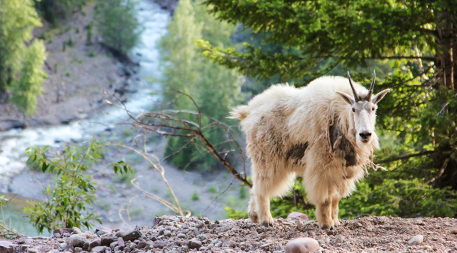
Changes at Glacier National Park are making it harder for iconic mountain goats to stay cool in summer months. Image by flickr.com/EvanLovely
The needs of humans aren’t the only concern as Glacier warms. Wolverines den in deep snow to give birth. “They’re a great sentinel species of cold climates,” says Mow. With less cold and snow, he says, they have an uncertain future in the park. Mountain goats, another iconic Glacier species, bed down on lingering snowpack to cool off in summer. “The areas where you’re accustomed to seeing goats wandering around, snow is not there,” says Mow. Pikas — the diminutive, rotund relatives of rabbits that live in rocks at high altitude — appear to be retreating to higher altitudes as climate warms. But the animals can retreat only so far on the mountaintops. Pikas have already vanished from some southern parks, including Zion and Bryce Canyon in Utah.
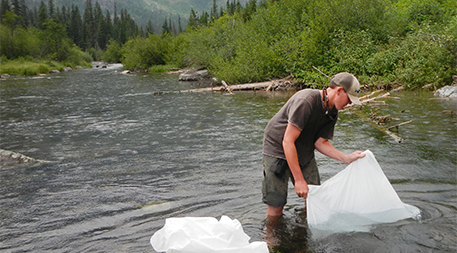
At Glacier National Park, fisheries managers are relocating bull trout to cooler waters upstream. Photo courtesy of Chris Downs / U.S. National Park Service
Losing a reliable source of icy meltwater would threaten the western glacier stonefly, known solely in a small area of Glacier National Park, where “it ’s uniquely adapted to stream waters that are fed by melting glaciers,” says Mow. Losing a steady supply of cold runoff also affects the bull trout, a native sportfish that is fighting a two-front war in Glacier, as in much of the West. On the one hand, loss of snowpack is raising stream temperatures where this heat-intolerant fish lives. At the same time, invasive lake trout — probably stocked by anglers — eat and outcompete bull trout at lower elevations.
In many instances, park managers are in wait-and-see mode. It’s not entirely clear what they can do to protect wolverines and pikas. But to protect other species, such as the bull trout in Glacier, wildlife biologists have taken a step that’s radical by the standards of the NPS, which is usually loath to move species: Fishery managers have caught native bull trout and transported them upstream of barrier waterfalls to upper reaches of mountain streams that are both cooler and — so far, anyway — free of marauding lake trout. “We’re trying to ensure the genetic lineage of those bull trout that survive in that watershed, so we are moving them up the watershed where historically they never existed,” Mow says.
Glacier is working with more than 30 land-management partners in the U.S. and Canada to plot a strategy for species that might lose out to a warmer climate.
The whitebark pineis another high-elevation species predicted to disappear from much of its current range within a few decades. Some scientists are already preparing to plant whitebark pine in areas more to the trees’ liking in years ahead, a strategy called assisted migration. “In some cases the strategy may be completely hands off, letting nature figure out if it’s resilient enough and see how it evolves. On the other end of the scale, the strategy might be assisted migration. Will we be moving plant species hundreds of miles north of their current range as a way of ensuring their survivability?”
Yet such a strategy will require a far greater land base than the national parks alone: Mow says Glacier is working with more than 30 land-management partners in the U.S. and Canada to plot a strategy for species that might lose out to a warmer climate. “To think that as superintendent of Glacier National Park that I am going to somehow navigate climate change just by managing the million acres I have here, boy, that’s very shortsighted,” he says.
Rising Waters
Coastal national parks are taking the brunt of a warming climate like few others. The combination of sea level rise and an apparent increase in severe weather is taking a toll on both natural features and human artifacts.
The response: Reinforce or retreat. Sometimes both.
Fort Massachusetts, part of Gulf Islands National Seashore, is a historic fortress on an eroding barrier island 12 miles off the Mississippi coast. As seas rose around it (but long before climate change was recognized as the cause), park officials opted to spend considerable money and effort to construct a rock jetty around the 19th century structure to hold off the waves, salt and erosion.
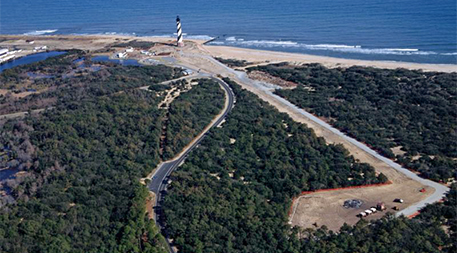
Formerly precariously seaside, Cape Hatteras’ 193-foot lighthouse moved inland to a new home in 1999. Photo courtesy of U.S. National Park Service
Cape Hatteras National Seashore had a different plan. Decades of erosion were threatening the lighthouse. Efforts to reinforce the coast and “nourish” the beach with additional sand failed to halt the march of the sea. So the park service decided in the late 1980s to move the 193-foot lighthouse a half-mile inland. Despite public opposition, proponents of moving the structure prevailed in 1999 — at a cost of nearly US$12 million.
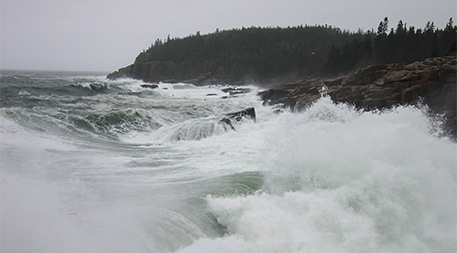
Engineers have redesigned historic roads at Acadia National Park to help protect them from violent storms. Photo courtesy of U.S. National Park Service
In Acadia National Park on Maine’s craggy coast, increasingly frequent storms have flooded and washed out roads listed on the National Register of Historic Places. Engineers have redesigned them to withstand storms while trying to keep them compliant with historic standards.
Assateague Island National Seashore is responsible for taking care of a popular beach in Chincoteague National Wildlife Refuge in Virginia but park managers have concluded that “maintaining the recreational beach in its present location is unsustainable in the face of continued storms, shoreline erosion, and sea level rise,” according to a 2015 report on NPS coastal adaption strategies. Park engineers have designed portable bathhouses and vault toilets that can be hauled to safer ground when destructive storms loom. But narrowing of the beach is making it difficult to maintain a parking lot. Park workers are considering moving the beach and its portable structures to a new location.

At Dry Tortugas National Park, it’s becoming increasingly challenging to protect Fort Jefferson from rising seas. Photo by iStock.com/ LorraineBoogich
But some things are too big to move. On Dry Tortugas National Park, about 68 miles west of Key West, waves and salt are eating away at the unreinforced masonry walls of 19th-century Fort Jefferson. “The strategy in Dry Tortugas, with the largest brick masonry structure in the northern hemisphere — that strategy is very different than at Cape Hatteras, where you do have the ability to relocate and move a lighthouse,” says Rebecca Beavers, NPS acting coastal adaptation coordinator. The park service has been stabilizing Fort Jefferson’s walls since the 1960s. But climate change scenarios are forcing the park to consider other remedies and even a future of operating a park just a few feet above the water’s surface. “That’s why adaptation we view as a process,” says Beavers. “It can have many strategies involved.”
The effects of rising seas are no less profound for Arctic parks. There, the damage is compounded by melting permafrost and the loss of sea ice that in the past blunted the force of winter storms. Now, those forces are ravaging the 1,000-mile shoreline of Bering Land Bridge National Preserve and Cape Krusenstern National Monument, where humans traveling the Bering land bridge and subsequent Arctic cultures built camps and settlements. “It’s such a rich archaeological site with tremendous cultural resources,” says Beavers. Exposed artifacts litter the bluffs along the eroding coast. The parks can’t prevent the erosion, but park managers are studying where erosion rates are greatest and where archaeological sites are most likely to occur so they can prioritize archaeological research at sites that are at greatest risk of being washed away.

Wetland restoration aims to literally stem the tide at Gateway National Recreation Area in New York. Photo by flickr.com/USACE NY
At Gateway National Recreation Area, the NPS is restoring wetlands at Jamaica Bay in New York. “We recognize wetlands as both habitat for species and even more used as a strategy in the Northeast post [Hurricane] Sandy to buffer the impacts from storm waves and surges,” says Beavers. Ecologists are designing the project to make sure wetland plants have a route to migrate inland and upslope as the water rises.
“It may have made a lot of sense at one time to have a bulkhead or a seawall at a location, but can we begin to remove some of those barriers along coastlines?” Beavers says. “It’s [a matter of] considering where the opportunities are for future habitat.”
Great Lakes park managers also expect park shorelines to change but are not sure how because precipitation in a warmer world is so hard to predict. And some changes are completely unexpected. At Isle Royale National Park in Lake Superior, both moose and wolves gained access decades ago by walking 15 miles or so over winter lake ice. Now the wolf population, which once numbered as high as 50, has dwindled to two and is probably doomed because of inbreeding. The opportunities for new wolves to cross the ice and replenish the populations are fewer as warmer winters mean fewer occasions when the lake is frozen. The park is studying its options, from translocating new breeding pairs of wolves to the island to start a new population, to letting moose overtake the island habitat unchecked by a predator.
Joshua Treeless
The effects of global warming on the nation’s deserts haven’t been as obvious as along its shorelines. Still, working with a range of scenarios, scientists have predicted that under the most severe warming, Joshua Tree National Park in California may become too warm for Joshua trees to reproduce and seed in 90 percent of the range where they currently live, though adult plants may persist.
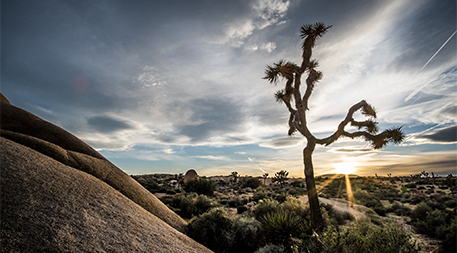
As climate changes, managers worry that Joshua Tree National Park may no longer be hospitable to its namesake vegetation. Image by flickr.com/giuseppemilo
Park managers are considering a range of responses, says Josh Hoines, who was vegetation branch chief at the park until recently. One extreme is to let nature take its course. The other is assisted migration of Joshua trees to suitable areas where they don’t exist now. In between might be collecting seeds and planting them in their current range if in the future it becomes too warm for the plants to seed naturally, or controlling invasive species to make life easier for the native ones. “All of those decisions are not taken lightly or undertaken haphazardly,” Hoines says, for fear that moving species outside their existing range will have unintended consequences.
Hoines recently became chief of resources at Death Valley National Park, officially the hottest place on Earth, with a record temperature of 134 °F (56 °C). An even hotter climate will threaten endemic species that are closely tied to the park’s scarce water, such as five species of pupfish and a number of riparian insects. “All of them would be highly at risk of extinction,” says Hoines. Also at risk of extinction or extirpation are species such as the Panamint alligator lizard and bristlecone pines that live at high altitudes in the park. “Their only recourse is to move up in elevation,” says Hoines. “At some point they run out of ‘up.’” The park is working with researchers from the University of California, Berkeley and other institutions to survey wildlife during the next year and compare the diversity they find to that recorded by surveys taken between 1908 and 1945. But an inventory is just a first step, says Hoines. Much tougher is figuring out how to respond to climate threats. “It truly is on a wait-and-see basis,” he says.
“What we do have and just experienced is uncertainty with precipitation,” Hoines continues. The lowest elevations of Death Valley average less than 2 inches of rain a year. But last October a series of rainstorms, including one that dumped more than 3 inches at once, sent a wall of water into Scotty’s Castle, an extravagant fortresslike home — now included on the National Register Historic Places — built by Chicago millionaire Albert Johnson. Some buildings were filled with up to 5 feet of mud, rock and other debris.
Stewarding for Change
National parks have, especially in recent decades, been managed with a light hand. In the words of the well-known 1963 Wildlife Management in the National Parks report (a.k.a. the Leopold Report), the goal was to preserve “a vignette of primitive America.” But the challenges of climate change have forced the park service to restate its goal to “steward NPS resources for continuous change that is not yet fully understood” — a phrase neither as evocative nor as reassuring.
Many potential responses to climate change — whether translocating native Joshua trees, reintroducing wolves to an island to control moose or reinforcing eroding beaches with dredge spoil — threaten hands-off values that have prevailed in the park service for decades. But Schuurman says the NPS Organic Act and the Wilderness Act (which affects the many designated wilderness areas in national parks) allow the NPS considerable latitude in responding to changing conditions. “There’s more flexibility than you may think,” he says. “It’s about making your case.”
But park managers also realize that the wild, open spaces many parks offer will have value even in a changing world.
In a 2012 memo to park superintendents, NPS director Jarvis said the agency’s policies “do not require what is impossible, economically infeasible, or likely ineffectual.” Clearly, Glacier National Park will not be able to save its glaciers. Many low-lying features in America’s coastal parks are goners too. Species of plants and wildlife are likely to disappear from parks where they now live, or even go extinct.
But park managers also realize that the wild, open spaces many parks offer will have value even in a changing world. Perhaps especially in a changing world.
“The reality is Glacier National Park wasn’t established just for its glaciers,” says Mow. “It was really established for its scenery and its location in the northern Rockies — the Crown of the Continent setting. It’s what was left behind that’s the showcase that people are looking at.”
There’s some evidence that changing climate will affect not just the parks themselves, but also the habits of park visitors.
Desert and tropical parks, such as Everglades National Park, may become increasingly intolerable to visitors during warmer summers. Peak visitation times may shift to cooler seasons. Says Beavers, “What we once considered the shoulder season may now become the main times that people visit parks.”
Parks in northern climes — which include most of the units in the national park system — may see more visitors as climate warms. According to a study by Schuurman and other park service researchers, park visitation across the nation has generally increased with warmer weather. The researchers predict climate change will boost visitation in most parks for most months, lengthen the visiting season at individual parks by up to a month, and increase visitation overall by as much as 23 percent. This could increase revenue and, in turn, resources available to keep the parks going strong. In fact, the authors conclude, national parks and nearby communities “that develop adaptation strategies for these changes may be able to both capitalize on opportunities and minimize detriment related to changing visitation.” ![]()
Ensia shares solutions-focused stories free of charge through our online magazine and partner media. That means audiences around the world have ready access to stories that can — and do — help them shape a better future. If you value our work, please show your support today.
Yes, I'll support Ensia!
